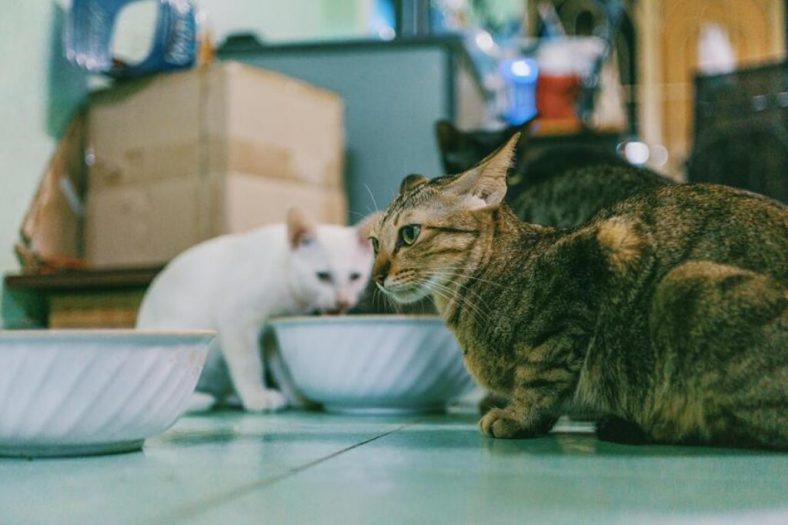Dos and Don’ts of Bowl Placement

When it comes to feeding your cat, where you place their bowls can make a significant difference in their mealtime experience. Placing them at the right height and in the appropriate location can impact their posture, digestion, and overall well-being. By following some simple dos and don’ts of bowl placement, you can create an environment that promotes healthy eating habits and reduces stress for your feline companion.
Optimal Height for Bowls
When placing your cat’s food and water bowls, ensure they’re at an optimal height for comfortable eating and drinking. Cats prefer to eat at a level that doesn’t strain their necks, so it’s best to position the bowls at about chest level when your cat is standing. This height allows them to maintain good posture while enjoying their meals.
Elevated bowls can be beneficial for cats, especially for older felines or those with arthritis. By raising the bowls, you can reduce the strain on their neck and joints, making mealtime a more pleasant experience for your furry friend. Additionally, elevated bowls can help prevent your cat from knocking them over, spilling food or water everywhere.
When choosing the right height for the bowls, consider your cat’s size and age. Kittens may need shallower bowls placed closer to the ground, while larger cats might require taller bowls. Observing your cat’s eating habits and posture can also provide valuable insight into the most suitable bowl height for them.
Separating Food and Water Bowls
Consider placing your cat’s food and water bowls in separate locations to encourage healthy hydration habits. Cats instinctively avoid drinking water close to their food source, as in the wild, water near prey could be contaminated. By separating the bowls, you can promote proper hydration and prevent potential dehydration issues.
Having the water bowl away from the food also encourages your cat to move around more, promoting exercise and mental stimulation. This separation can help prevent your cat from overeating too, as they won’t be tempted to eat just because they’re near their water source.
When placing the water bowl, ensure it’s in a quiet and peaceful area to encourage your cat to drink regularly. Keep the water fresh and clean by changing it daily and washing the bowl regularly. By separating the food and water bowls, you’re providing your cat with an environment that supports their natural instincts and encourages healthy habits.
Avoiding High-Traffic Areas
To prevent disturbances and ensure your cat’s mealtime comfort, place their food and water bowls in areas with minimal foot traffic. Cats are sensitive creatures, and loud noises or constant movement around their feeding area can cause stress and anxiety, leading to decreased appetite or even mealtime avoidance. By choosing a quiet and low-traffic spot for their bowls, you create a peaceful environment where your cat can eat without distractions.
High-traffic areas like hallways, near doorways, or close to the kitchen where people frequently pass by aren’t ideal for feeding stations. Cats prefer calm and quiet surroundings when they eat, as it mimics their natural instinct of hunting in solitude. Placing their bowls in a secluded corner or a quiet room can help them feel safe and relaxed during mealtime.
Providing Multiple Feeding Stations
For optimal feeding convenience and to accommodate multiple cats, positioning feeding stations in different areas of your home can help prevent competition and reduce mealtime stress. Cats are territorial animals, and having multiple feeding stations allows each cat to eat without feeling threatened by other pets. Placing feeding stations in separate rooms or corners of your home can create a sense of privacy during mealtime, reducing the likelihood of food guarding or aggressive behavior.
Having multiple feeding stations is especially important in multi-cat households where cats may have different dietary needs or eating habits. Some cats prefer to eat small amounts throughout the day, while others may prefer larger meals at specific times. By providing multiple feeding stations, you can cater to each cat’s individual preferences and ensure they all have access to food when they need it.
Additionally, having multiple feeding stations can help prevent food-related conflicts between cats, ensuring a more harmonious mealtime experience for everyone involved. Consider placing feeding stations in quiet, low-traffic areas to further reduce stress and promote a peaceful eating environment for your feline companions.
Keeping Bowls Away From Appliances
Are your cat’s food and water bowls placed away from appliances in your home? It’s crucial to ensure that your feline friend’s feeding area is situated far from any household appliances. Cats are naturally curious creatures, and they may accidentally knock their bowls into appliances while eating or drinking, leading to spills or even injuries. Placing the bowls near appliances also increases the risk of food contamination from spills or splashes caused by the appliance’s operation.
To prevent any mishaps, consider designating a separate area specifically for your cat’s feeding station, away from appliances like refrigerators, dishwashers, or stoves. This won’t only keep your cat safe but also maintain a clean and hygienic feeding environment. Additionally, keeping the bowls away from appliances can help create a quiet and stress-free eating space for your cat, as loud appliance noises can disrupt their mealtime peace. By being mindful of bowl placement, you can ensure a safe and enjoyable dining experience for your beloved pet.
Trending Products










